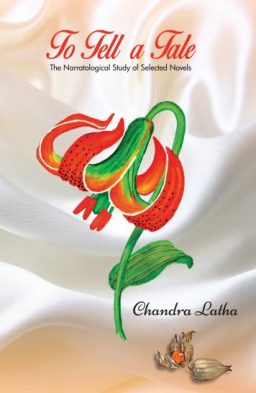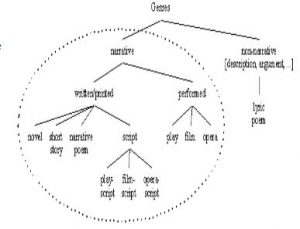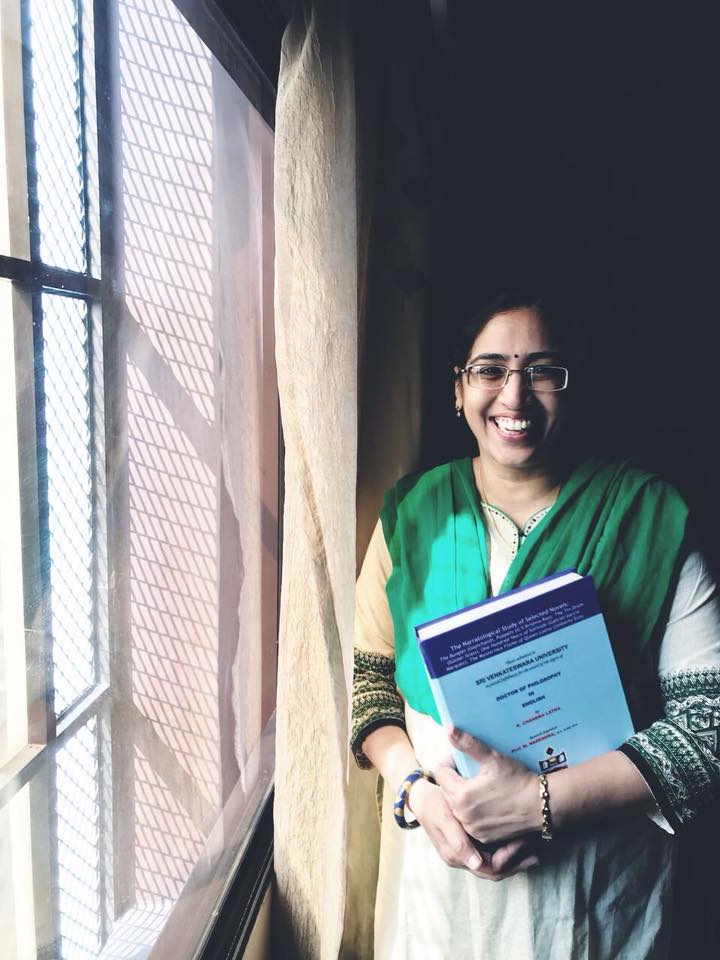
To tell a tale-2
-Chandra Latha
Chapter-I
Narratology and Novel
The human being is considered a thinking animal and he is a social being by nature. One can surmise that the human being’s psychological inclination for communication is shaped the emergence of a society. The narration is seeded in the dire necessity of meaningful communication expressed in a sequential order. The body language of gestures and sounds eventually developed into speech. And then, the speech attained a form by the evolution of a script. Speech and script developed into a language which served to meet the need of varied functions of basic and complex human communication involving human thought and emotions.
The man’s attempt to narrate his experiences might have demanded the development of an effective tool of communication and the speech fulfilled that need. The human being might have indulged in a narrative, through gestures and actions even before the invention and evolution of speech. The magnificent matrix of sound and form, empowered and enriched human narrative skills.
Human survival, existence and prevalence, thus and hence, are deeply rooted in human narrative skills. The narrative skill is a unique tool which assimilates the human rationale and fantastic imagination. Human narrative skill that transcends human thought and emotion, by and large, is organic, dialogical and emerging. Oral tradition is not merely confined to the narratives of the incidents of daily routine or different experiences in the mundane world, but they were inclusive of human inner spaces and extraordinary imaginations of fantastic worlds, thus influencing and chiseling the natural human abilities. Novel is comparatively the later genre of literature. A novel is, normally, a long prose narrative that depicts the experiences of fictional characters in created situations that eventually develop into a form of a sequential story. Mikhail Bhaktin emphasizes that “Novel is a genre of becoming” (M.M.Bhakthin, Pg.17) and he traces novel’s roots into the oral tradition of the folk tale that has no narrative structures or rules of narration. By nature, novel is an organic and ever emerging literary genre.
This study of narratology of selected novels will introduce, the fundamentals of the narratology and the novel in general, and also, the scholastic relationship between these two independently emerged scientific fields.
The term narrative is originated from the Latin verb narrare, which means “to recount” and is related to the adjective gnarus, meaning “knowing” or “skilled”. (Derived from the proto- Indo–European root gnō-, “to know”) Narratology is defined as the study of “theory, discourse or critique of the Narrative/narration” (J.A.Cuddon. Dictionary of Literary terms and Literary Theory. Penguin. 1998 edition. Pg. 533) and a humanities discipline dedicated to the study of the logic, principles, and practices of narrative representation.
The term Narratology is the Anglicization of the French term narratologie. It was first coined by Tzvetan Todorov, in Grammaire du Décaméron, (1969), ‘who argued for a shift in focus from the surface level of text-based narrative (i.e. concrete discourse as realized in the form of letters, words and sentences) to the general logical and structural properties of narrative as a univers de représentations .’ (Tzvetan Todorov. Grammaire du Décaméron, Published by Mouton & Co. 1969. Page 23)
Todorov thus called for ‘a new type of generalizing theory that could be applied to all domains of narrative’, and in fact for a hypothetical “science that does not exist yet; let’s call it Narratology, or science of narrative.” (Tzvetan Todorov, Grammaire du Décaméron. Mouton & Co., The Hague Paris, 1969). And, he further explained Narratology as the theory of the structures of narrative.
Narratology has developed into a variety of theories, concepts, and analytic procedures. Its concepts and models are widely used as heuristic tools, and narratological theorems play a central role in the exploration and modeling of our ability to produce and process narratives in a multitude of forms, media, contexts, and communicative practices. Practically, all theories of narrative distinguish between what is narrated, the story and how it is narrated, the discourse. (J.A.Cuddon. Dictionary of Literary terms and Literary Theory. Penguin. 1998 edition. Pg.534)
To investigate a structure, or to present a structural description, the narratologist dissects the narrative phenomena into their component parts and then attempts to determine functions and relationships. More precisely, narrative can be defined as anything that tells or presents a story which is a sequence of events involving characters.
Narration is one of the most important rhetorical modes of discourse that express the variety, conventions and purposes of the writing, the other significant rhetorical modes being description, exposition and argumentation.
As one of the four important rhetorical modes of discourse, the purpose of narration is to tell a story or to narrate an event or series of events. Narrative may exist in a variety of forms, including biographies, anecdotes, oral histories, short stories and novels. Genard Genette and few other theorists restrict their options to verbally narrated texts whereas Barthes, Chatman and other theorists argue that anything’ that tells a story, in whatever genre constitutes a narrative’. (J.A.Cuddon. Dictionary of Literary terms and Literary Theory. Penguin. 1998 edition. Pg.533) Thus, a narrative can be defined as a story that is emerged in a sequential structure and format, in the forms of written, spoken, poetry, prose, images, song, film or theatre, and which describes a series of fictional or non-fictional events.
Narratives of the world are also “numberless,” says Barthes (1982) (Ronald Barthes, Mythologies; Seuil, Paril Readerly Text/Writerly texts https://en.wikipedia. org/ wiki/Roland_Barthes. 1957. Pg.252)

Narratives appear in the infinite diversity of forms, narrative is present “in every age, in every place and every society…” (Jahn, Manfred. 2005. Narratology: A Guide to the Theory of Narrative. English Department, University of Cologne.Version: 1.8. Pg.N2.2.1). Narratology is omnipresent and omnipotent and thus concerned with all types of narratives, literary and nonliterary, fictional and nonfictional, verbal and non-verbal. (Jahn, Manfred. 2005. Narratology: A Guide to the Theory of Narrative. English Department, University of Cologne.Version: 1.8. Pg.N 2.2.1) Jahn, Manfred notes down ‘a taxonomy which imposes a kind of order on Barthes’ list’ in a neat diagram: (Jahn, Manfred. Narratology: A Guide to the Theory of Narrative. English Department, University of Cologne. 2005. (http://www.uni-koeln. de/~ame02/pppn.htm)
Manfred rightly argues that, “the diagram is not exhaustive but lists representative and typical genres” and focuses on Chatman’s method to “assume that each tree node has an additional branch leading to an implicit other category, and that this may serve as an empty slot that can be filled with any new category that might come up” (Jahn,Manfred. 2005. Narratology: A Guide to the Theory of Narrative. English Department, University of Cologne. (http://www.uni-koeln.de/~ ame02/ pppn. htm)
Narration is considered as an important tool for sequencing or constructing a logical order in presenting the information. Narrative ultimately attempts to emerge in clear sequences of creative and logical expressions. Claude Lévi-Strauss, advanced the idea that myths are variations on basic themes and that in their totality their narratives contain certain constant, basic and universal structures by which any one myth can be explained. Lévi-Strauss sees myth as a kind of language which can be broken down into individual units or my themes. (J.A.Cuddon. Dictionary of Literary terms and Literary Theory. Penguin.1998 edition. Page 534)
Myths can be read in relation to each other rather than as reflecting a particular version. Hence the concept of a kind of ‘grammar’ or set of relations underneath the surface of the narrative. He also advances the idea that the myths have collective existence independent of individual thought, and posits myths as related to other myths rather than to truth and reality. They are ‘outside’ de-centered, and posses their own truth and reality.
*****

Chandra Latha, writer from Nellore won Telugu Association of North America award in 1997 for the novel “Regadi vittulu”. Her other novels are Vardhani(1995) and Vallu veellu paarijaataalu (2011). Her short fiction includes nearly 80 stories compiled in nenu nanna navutha (1996),Idam shareeram (2003) and vivarnam(2007). Her non-fiction are (Fish can fly!) ”vacche daretu(2010), itanala kadaku eeboothi boTlu(2010). And also published her blogposts in a book madata pejee(2010).
